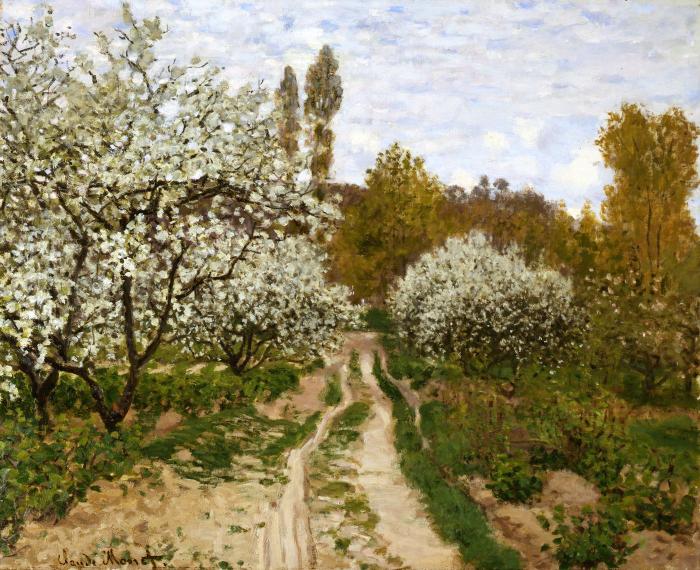Sally Metzler
Chicago, Illinois, USA
 |
| Fig. 1: Claude Monet, Apple Trees in Blossom, 1872, Union League Club of Chicago. |
 |
| Fig. 2: Claude Monet, The Japanese Footbridge, ca. 1922, Modern Museum of Art New York. |
No other artist in the world is more beloved than Claude Monet (1840-1926), the father of French Impressionism. From Shanghai to Chicago, his name lighting up any museum marquee will assuredly attract thousands of visitors. Endowed with an inexplicable ability, he applied a magical formula of artistic expression to impart a fresh, optimistic world-view on canvas, wherein sunlight, blossoming trees, and blue skies formed the principal ingredients of visionary delight. Monet communicated a palpable atmosphere, redolent with sunshine and the reflective qualities thereof on the landscape. French Impressionism went global, sweeping through the salons of Europe and America in particular, and nearly every school of art in every land adopted his loose brushwork to suit their particular geography. Today, California Impressionism and New York Impressionism are venerated as styles in their own right.
On the other hand, life for Monet was not one continuous blooming garden. At one time or another, he suffered financially, physically, and mentally. Most readers are vaguely familiar with his affliction of cataracts, diagnosed at the age of sixty-eight after returning from a trip to Venice in 1908.1 The onset of his deteriorating sight is important in evaluating his oeuvre as his impressionistic style initially was a choice, not the result of failing eyesight. A painting from 1872, Apple Trees in Blossom (fig 1), created when he would have been thirty-two, demonstrates his early artistic method, exploiting a nuanced impressionistic style. The bucolic, scenic landscape celebrates a garden in Argenteuil, a commune in the northwest suburbs of Paris where Monet lived for a short time. Though he eschewed sharp delineation and firm contours throughout the composition, the primary elements are recognizable. In contrast, a work from the final decades of his life, when his vision had diminished significantly, shows a nearly abstract painting (fig. 2). Were it not for the title ascribed (The Japanese Footbridge), one would find difficulty in discerning the subject and inherent objects.
Less known are the other illnesses that plagued Monet and his nuclear family, which impacted his general health, well-being, and concomitantly his art. At age twenty one, while in Algeria serving his military obligation, he contracted typhoid fever, the basis of his early discharge. Interestingly, his father offered to buy his way out of being conscripted, under the stipulation that Monet renounce the aspiration of pursuing art. Claude flatly refused, and initially found Algeria pleasant; the vibrant colors and landscape awakened and engaged his artistic senses. He managed to survive such a virulent illness and returned to France where he resolved to make a living as an artist.
Though today universally held in high esteem, he struggled for years to become a respected and successful artist. Depression would be an enemy to his equanimity throughout much of his life but most acutely as a young man trying to make his way in the world. An early relationship with one of his models, Camille Doncieux, resulted in a son;2 the couple eventually married, much to the disapproval of his parents, who subsequently curtailed previous financial support. Feeling the burdens of family and finances, he fell into such deep despair that in 1868 he attempted suicide, jumping off a bridge into the Seine River. The stressful circumstances took a toll on the health of his wife as well “. . . Camille . . . she takes to drink and her general condition is rapidly deteriorating. The doctor diagnoses uterine cancer with liver and kidney metastases.”3 She died in 1879, leaving Monet a widower at age thirty-nine. Though he remarried, he again would be a widower, as his second wife Alice succumbed to myeloid leukemia in 1911.
Once he achieved financial and artistic success, at the age of fifty he purchased two acres in a small village called Giverny. He discovered it one afternoon gazing out of a train window. It piqued his interest, and he resolved to return and explore. There he would find countless vistas for inspiration and, most importantly, a peace of mind that had eluded him for decades. Among his works was a series of waterlily paintings, universally admired as icons in the history of art. He enlarged the initial property and cultivated splendorous gardens that today attract millions of visitors (figs. 3, 4, 5, 6).
But the last decade of his life became increasingly difficult as his cataracts overwhelmed his sight, his ability to paint, and his mental state. Reluctantly, he underwent two surgeries in 1923 for cataracts. One had to be halted as he suffered a nervous breakdown. In 1926, after he developed a troubling cough, an x-ray revealed he had lung cancer, though his family shielded him from the diagnosis. He died the last month of the year of 1926, on December 5. Claude Monet had spent the last four decades of his life cultivating his garden in Giverny, enlarging the original house, and of course painting his own backyard at various times throughout the day in varying sunlight and seasons. He could have never imagined that these impressionistic visions of his own backyard would one day be valued as masterpieces, admired throughout the world.
 |
 |
 |
 |
| Figs. 3, 4, 5, and 6: Gardens of Giverny, France. Photography by Dr. Leslie Sandlow. | |
Notes
- For the medical issues of his cataracts and the implications on his art, see: Peter Kopplin, “Monet and his cataracts,” Hektoen International, Volume 9, Issue 1, Winter 2017.
- The couple would have another son together, the youngest named Michel.
- See Castillo-Ojugas A., p. 681 for Camille’s diagnosis and in general: “Influencia de la enfermedad en la pintura de Matisse y de Monet” [Influence of disease on Matisse and Monet painting]. Anales de la Real Academia Nacional de Medicina (Madrid) 2003;120(4):675-688.
SALLY METZLER, PhD, is the director of the art collection for the Union League Club Chicago.
Highlighted in Frontispiece Volume 13, Issue 1 – Winter 2021
Summer 2020 | Sections | Art Essays

Leave a Reply